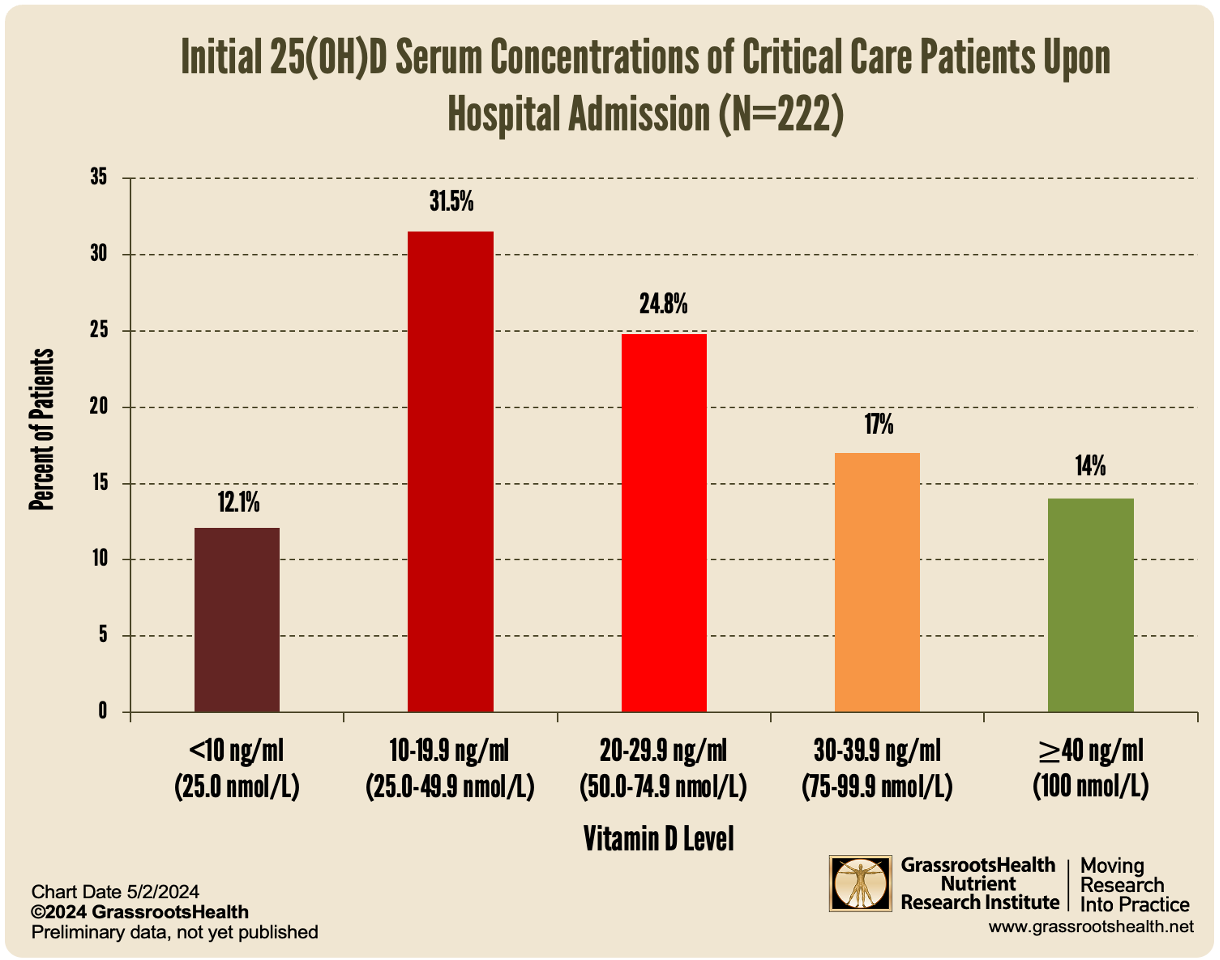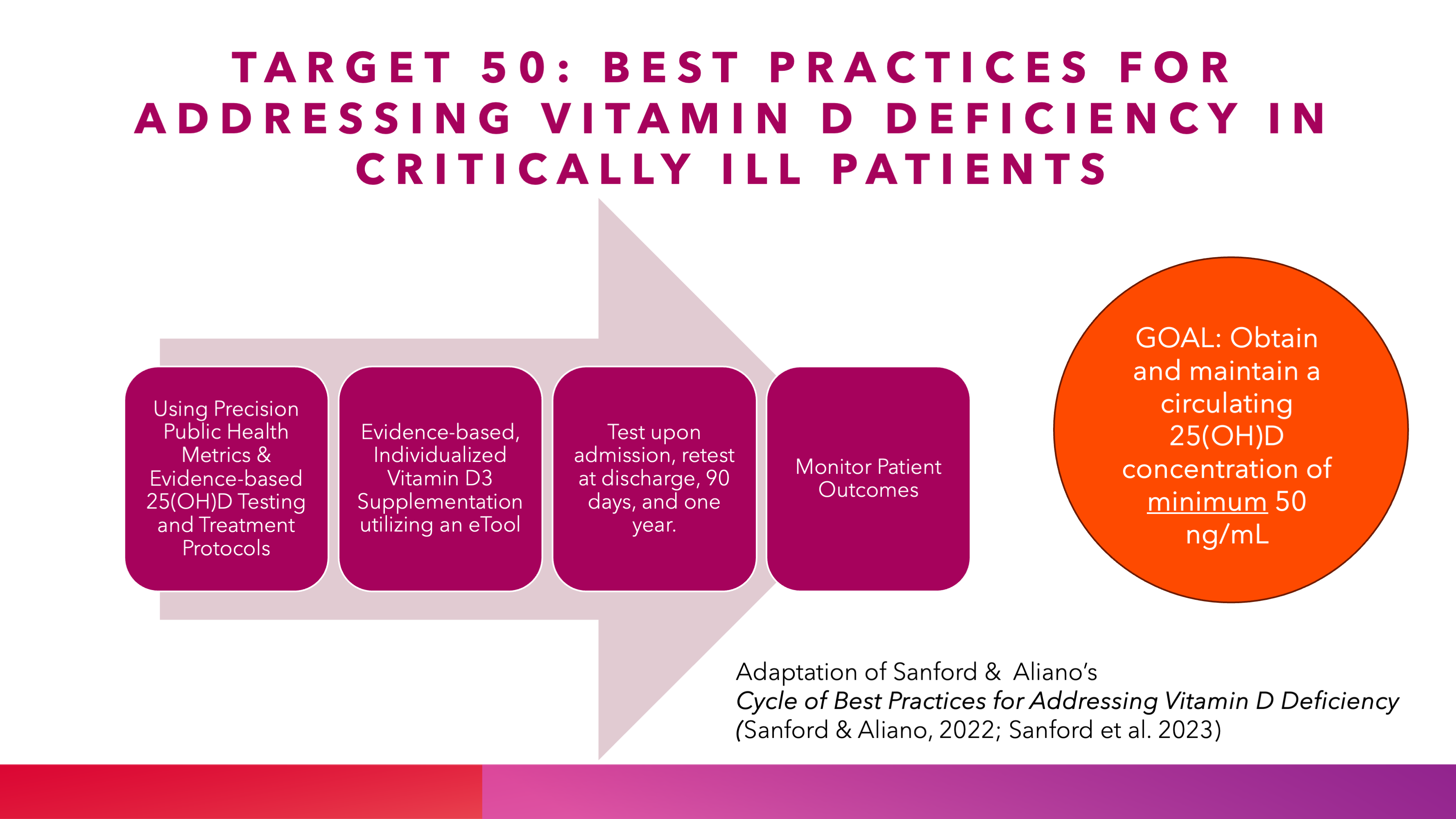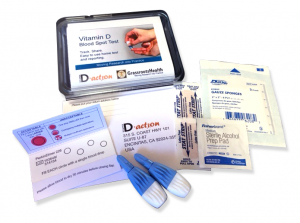Published on January 9, 2025
Optimizing vitamin D levels to 50 ng/ml among critical care patients resulted in reduced hospital acquired infections and improved patient outcomes
Key Points
- A critical care hospital in North Dakota implemented protocols to achieve a target vitamin D level of 50 ng/ml while educating hospital staff and patients about vitamin D; after project implementation, patients experienced reduced infection rates with trends of decreased re-admittance to a higher level of care, an increased number of patients discharged to home or rehab, decreased discharges to skilled nursing facilities, and decreased overall length of hospital stay.
- Dr. Leslie Ray Matthews, an intensive care doctor and critical care surgeon, tested vitamin D levels for all patients upon hospital admission and supplement them with 50,000 IU vitamin D3 per day. Working in the 4th busiest level 1 trauma center in the US, he was able to cut the rate of heart attacks, strokes, falls, pneumonia, and overall mortality while also lowering readmissions, the length of hospital stays, and healthcare costs just with vitamin D. There were zero cases of vitamin D toxicity.
- GrassrootsHealth provides a proven implementation model, education, tools, research and findings to help those interested in moving vitamin D research into practice. Contact us for a free 30 minute consultation.
 Results are in from a vitamin D quality improvement program implemented among critical care patients at Vibra Hospital in Fargo, ND, under the guidance of Beth Sanford, DNP, RN and GrassrootsHealth, which began in early 2023.
Results are in from a vitamin D quality improvement program implemented among critical care patients at Vibra Hospital in Fargo, ND, under the guidance of Beth Sanford, DNP, RN and GrassrootsHealth, which began in early 2023.
Using protocols to achieve a target vitamin D level of 50 ng/ml (125 nmol/L) while educating hospital staff and patients about vitamin D resulted in more than just reduced infection rates. The hospital also saw decreased re-admittance to a higher level of care, an increased number of patients discharged to home or rehab, decreased discharges to skilled nursing facilities, and decreased overall length of hospital stay.
Following implementation of the project, the hospital received a letter from the North Dakota Health and Human Services to congratulate them on their Hospital Acquired Infections Rankings, which were much improved when compared to previous years. The letter stated,
“The Public Health Division, Healthcare Associated Infections Program would like to extend their appreciation to you and your staff for your efforts in reducing hospital acquired infections. Each year we are continuing to see improvements with many of our hospitals meeting or exceeding national requirements. By doing so, you are helping to provide a safe environment and quality care to North Dakota patients.”
Could the impact on hospital acquired infections have been due to vitamin D alone?
 It wouldn’t be the first time such results were achieved in a hospital setting. Last year, we featured an interview with Dr. Leslie Ray Matthews, M.D., FACS, FCCM, who practiced as a hospital intensive care doctor and critical care surgeon. Dr. Matthews’ knowledge of the biochemical and physiological actions of vitamin D within the body, combined with his awareness of the prevalence of vitamin D deficiency, prompted him to test vitamin D levels for all patients upon hospital admission and supplement them with 50,000 IU vitamin D3 per day. Working in the 4th busiest level 1 trauma center in the US, he was able to cut the rate of heart attacks, strokes, falls, pneumonia, and overall mortality while also lowering readmissions, the length of hospital stays, and healthcare costs just with vitamin D! And, there were zero cases of vitamin D toxicity. As he says,
It wouldn’t be the first time such results were achieved in a hospital setting. Last year, we featured an interview with Dr. Leslie Ray Matthews, M.D., FACS, FCCM, who practiced as a hospital intensive care doctor and critical care surgeon. Dr. Matthews’ knowledge of the biochemical and physiological actions of vitamin D within the body, combined with his awareness of the prevalence of vitamin D deficiency, prompted him to test vitamin D levels for all patients upon hospital admission and supplement them with 50,000 IU vitamin D3 per day. Working in the 4th busiest level 1 trauma center in the US, he was able to cut the rate of heart attacks, strokes, falls, pneumonia, and overall mortality while also lowering readmissions, the length of hospital stays, and healthcare costs just with vitamin D! And, there were zero cases of vitamin D toxicity. As he says,
“Vitamin D deficiency is deadlier than vitamin D toxicity!”
Dr. Matthews wraps up the interview with key points and important advice that is essential for other health care practitioners to hear, especially if they are interested in keeping their patients healthy. They can make a big difference for their patients, simply by increasing their knowledge of vitamin D and by testing for and treating vitamin D deficiency – just as the healthcare workers at Vibra Hospital did!
Watch the Interview with Dr. Matthews Here
More About the Vibra Hospital Project
 Vitamin D deficiency is prevalent among critically ill patients and is associated with adverse outcomes such as increased risk for hospital acquired infections, delayed wound healing, increased pain, increased cerebral swelling, skin breakdown, and patient mortality. Research shows that vitamin D levels may be a modifiable risk factor for these medical complications and many others.
Vitamin D deficiency is prevalent among critically ill patients and is associated with adverse outcomes such as increased risk for hospital acquired infections, delayed wound healing, increased pain, increased cerebral swelling, skin breakdown, and patient mortality. Research shows that vitamin D levels may be a modifiable risk factor for these medical complications and many others.
Recognizing the importance of addressing this issue, Vibra Hospital chose to implement the quality improvement (QI) project aimed at achieving and maintaining serum 25(OH)D concentrations at a minimum of 50 ng/mL among patients admitted. The project involved the use of a standardized admission screening, evidence-based e-tool to create individualized patient supplementation and dosing, interdisciplinary education initiatives for the health care providers, and tracking patient outcomes. The preliminary data reported was collected over the first 12-month period.
What were the results of the vitamin D project?
Preliminary findings support the need to address vitamin D levels in hospitalized patients; upon admission, 44% of patients had a vitamin D level below 20 ng/ml, with 12% below 10 ng/ml (N=222). A significant number of patients in the program were able to achieve and maintain optimal vitamin D levels following individualized vitamin D repletion protocols.
Analysis of patient outcomes revealed potential benefits associated with optimized vitamin D levels, including reduced infections overall and zero cases of CAUTI (Catheter-Associated Urinary Tract Infection) in the first year. Resulting trends included decreasing re-admittance to a higher level of care, an increasing number of patients discharged to home or rehab, decreasing discharges to skilled nursing facilities, and decreasing overall length of stay.
Implement Your Vitamin D Quality Improvement Project
The following power-point presentation, prepared by Dr. Sanford, Bonnie Vangerud, MSN, RN, CCO of Vibra Hospital, and Kristen Schimmel, MSN, RN, Education Coordinator of Vibra Hospital, outlines further details about implementation of the project, results, and additional insights.
Enhancing patient outcomes: Insights from year one of a vitamin D quality improvement initiative in critical care
Access the Presentation Slides Here
Proven Implementation – Request a Free Consultation Today!
GrassrootsHealth provides a proven implementation model, education, tools, research and findings to help those interested in moving vitamin D research into practice.
- Test vitamin D levels and maintain ≥ 40 ng/ml
- Education for providers and patients
- Track to see how health outcomes improve
- Reduce costs
“Precision public health metrics, evidence-based protocols and precision medicine e-Tools take the guess work out of repleting yours and your patients’ vitamin D concentrations.” Dr. Beth Sanford
Contact Dr. Sanford, who is also an Advisory Board Member of GrassrootsHealth, by emailing her at [email protected] for a free 30 minute consultation about starting a clinical innovation/quality improvement project today.
How Are Your Levels of Vitamin D and Other Important Nutrients?
Check your vitamin D, omega-3s, magnesium, and other important markers today as part of the vitamin D*action project!
Measure your:
- Vitamin D
- Magnesium PLUS Elements (including zinc, copper, selenium, mercury, cadmium and lead)
- Omega-3 Fatty Acids
- hsCRP (for Inflammation)
- HbA1c (for Blood Sugar)
- and more
Did you know that each of the above can be measured at home using a simple blood spot test? As part of our ongoing research project, you can order your home blood spot test kit to get your levels, followed by education and steps to take to help you reach your optimal target levels. Start by enrolling and ordering your kit to measure each of the above important markers, and make sure you are getting enough of each to support better health and wellbeing!
Start Here to Measure Your Levels








